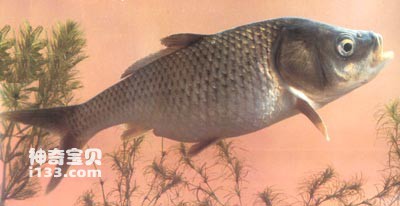Big-headed carp (Cyprinus (C.) pellegrini) belongs to the order Cypriniformes, family Cyprinidae, subfamily Cyprinus, and genus Cyprinus. Commonly known as: big-headed fish, Luyu ("Chenjiang Prefecture"). English name: Barbless carp.
Endangerment level: Vulnerable. China's national level II protected wildlife.
The body shape is like a carp. The tail peduncle is slender. The head is particularly large and broad, and the length of the head is greater than the body height and the base length of the dorsal fin; the back of the head is broad and flat. The mouth is broad and large, sub-superior, arc-shaped, the oral cleft is significantly inclined, and the width of the mouth is greater than the length of the muzzle. No need. The crown of the second main row of hypopharyngeal teeth has 2-5 grooves. The gill rakers are arranged very finely, with more than 48 rakers, and their length exceeds the length of the gill filaments. The scales are large, with 34-37 lateral line scales. Both the dorsal and anal fins have finely serrated spines. The starting points of the dorsal and pelvic fins are opposite or the dorsal fin is slightly longer, the dorsal fin base is long, the fin rays are short, the outer edge is deeply concave, the pectoral, ventral and anal fins are all large; the pectoral fin reaches the ventral fin. The back of the body is blue-gray, the abdomen is silver-white, the dorsal fin is gray-black, the even fins and caudal fin are light yellow, and the lower leaf of the caudal fin is reddish.

It likes to live in the middle and upper layers of water bodies with deep water quality and relatively clear water quality. It has poor tolerance to harsh environments. If the water quality is turbid or leaves the water body, it will die easily. Sexually active, swims quickly. The feeding habits are relatively simple, and there is little difference in the feeding habits between large and small individuals. Almost all of them feed on large zooplankton, cladocerans and copepods; sometimes they also eat some diatoms, filamentous algae and turtle-shell rotifers, but the number is very small. Generally, female fish are sexually mature when their weight is around 50 grams, and their spawning period is relatively long, starting from early April until September, with peak spawning in May-June. The eggs hatch on aquatic plants.
The big-headed carp is endemic to my country and is only distributed in Xingyun Lake and Qilu Lake in Yunnan Province. Because of its tender meat, high fat content and delicious taste, it is very popular among people. In the 1950s and 1960s, it was the main economic fish in the production area, accounting for about 70% of the total production in the two lakes. Since the introduction of silver carp and bighead carp in the 1970s, they have competed with bighead fish for food. During the introduction, small wild fish such as goby, giant catfish, and wheat ear fish were also introduced. These fish have strong vitality and eat large amounts of fish eggs; Then the lake water level dropped, the aquatic plants decreased and the spawning grounds were destroyed; long-term overfishing; the bullhead's own weak disease resistance, slow growth, poor adaptation to the environment and other comprehensive factors have led to a sharp decline in resources. Currently, the bullhead is in Nebula. Lake and Qilu Lake account for only about 0.5% of fish production.
animal tags:
We created this article in conjunction with AI technology, then made sure it was fact-checked and edited by a Animals Top editor.